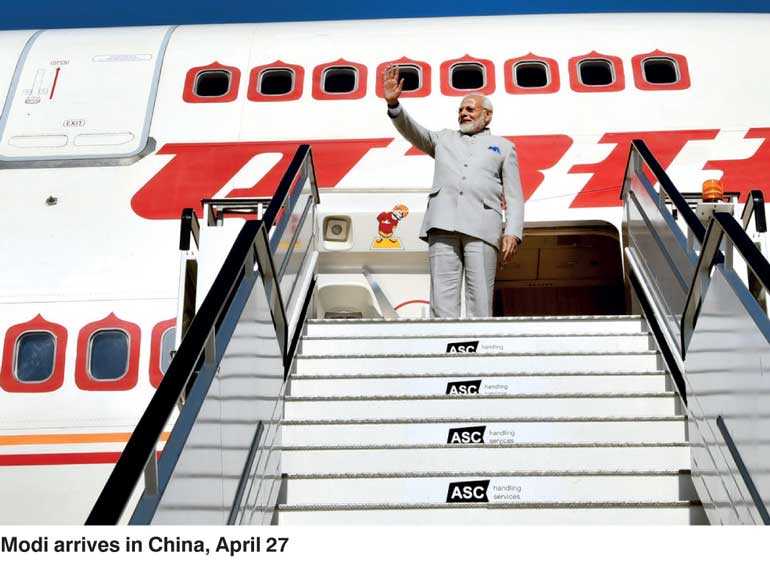Monday Jan 12, 2026
Monday Jan 12, 2026
Saturday, 28 April 2018 00:00 - - {{hitsCtrl.values.hits}}
 In an unprecedented move welcomed by all sections in India and China, Indian Prime Minister Narendra Modi and the Chinese President Xi Jinping decided to have an unstructured, informal, one-on-one meeting with each other in Wuhan spread over two days beginning on Friday 27 April.
In an unprecedented move welcomed by all sections in India and China, Indian Prime Minister Narendra Modi and the Chinese President Xi Jinping decided to have an unstructured, informal, one-on-one meeting with each other in Wuhan spread over two days beginning on Friday 27 April.
Through such unconventional diplomacy, the two leaders hope to thrash out all issues dividing the Asian giants and put them on a path of peace, cooperation and progress.
The attempt will be to look beyond the exigencies of the present and work out a “shared future” (to use Xi’s expression) in a world which is rapidly changing in direction not conceived before.
The dominant power in the region and the world since World War II, the United States, is confused under the stewardship of Donald Trump. At any rate, the US appears to be a declining power in the face of China’s unparalleled rise, and Russia’s resurgence.
And, as Tang Lu, Research Fellow at Xinhua’s Think Tank points out in her recent article, Modi has not got what he expected from the Trump Administration, despite having good personal vibes with Trump himself.
The American policy of using economic sanctions and military action to cow down Third World countries has been driving the latter into the waiting arms of China, the rising power.
China, and not the West, is now the aid giver and development financier of the world, and countries wanting to pull themselves out of poverty and under development by their bootstraps, are now eagerly accepting China’s largesse running into billions of dollars, disregarding the West’s dark warnings of a debt trap.
As the Sri Lankan developmental expert Prof. H.M.S.K. Hennayake put it: “The West comes with a bag full of advice and but not a cent.” In short, the West does not address the felt needs of the developing world.
Ironically, the original apostle of free trade and globalisation, the US, is now a practitioner of protectionism, and China, a classic case of a closed economy, is now an advocate of free trade and globalisation through its Belt and Road and other initiatives.
For Modi to solve some of the problems India faces, such as funding for infrastructural development, tackling terror-sponsoring Pakistan, and entering the Nuclear Suppliers’ Group, (NSG) a friendly China is a sine qua non.
Firstly, it is only China which can infuse huge funds into infrastructural development in India, which is a crying need of the hour. And if India is to join the Nuclear Suppliers’ Club, and get the UN to list the Pakistan-based terrorist Masood Azhar as a global terrorist, it has to get China on board through an attractive deal.
It makes sense to develop a new synergy with China so that these hurdles are crossed and India is put on the path of development to satisfy the yearnings of its ever burgeoning, aspirational and vocal middle class.
Past efforts have paid off
In the past, Indian leaders have broken the ice with China by making path breaking visits. But Modi’s effort has been different, at once secretive and dramatic, in keeping with his political style. Secondly, as Tang Lu, pointed out, the Modi-Xi meeting will be the longest informal interaction between an Indian and a Chinese top leader. It will be over two days. This is why so much is expected of the “Wuhan moment,” Tang Lu says.
Every earlier move towards rapprochement between India and China has paid off. It was Prime Minister Rajiv Gandhi who broke the ice with China by his visit to Beijing in 1988, the first by an Indian PM after the 1962 military conflict. Rajiv’s foray resulted in the two sides pledging adherence to the Five Principles of Co-existence worked out by Jawaharlal Nehru and Chou-En-Lai in 1954.
The push factor in Rajiv Gandhi’s case was his commitment to putting India on a path of development through a combination of economic liberalisation and settlement of political disputes by entering into Agreements.
Then came Prime Ministers P.V. Narasimha Rao and A.B. Vajpayee, both of whom sought a détente with China to further their liberalised economic agendas at home. Narasimha’s Rao visit resulted in the signing of the very successful ‘Peace and Tranquillity Agreement’ on the India-China border in 1993. The pact opened the door for bilateral trade which was abysmally low at that time. Thanks to the opening up, China has now become India’s single largest trading partner.
Vajpayee’s visit to China, which took place in 2003, obtained “equal security” for India and China on the border, and ensured the continuity of the 1993 pact. The brief Vajpayee had given to his diplomats was that they should improve bilateral relations and do whatever it took to get there. This encouraged out-of-the-box thinking.
The net result of these efforts is that, till date, and even during the Doklam standoff in 2017, not a shot has been fired by either side on the 1,400 km long Sino-Indian border since 1962. Contrast this with the situation on the border with Pakistan, where not a day passes without firing across the border.
With trade came investment, but this did not go up to the levels desired because of India’s security considerations.
However, according to Forbes, there is a lot of Chinese investment and these are under the radar because they come via third countries. But what is worrying is the burgeoning trade deficit caused by China’s barriers and its policy of buying primary and intermediate goods from India and selling manufactured goods.
Even as trade was booming India-China relations kept seeing setbacks at the political level. China was supporting Pakistan’s nuclear armament and turning a blind eye to its cross border terrorism. China built the China-Pakistan Economic Corridor (CPEC) across Gilgit-Baltistan over which India has a claim.
Above all, in 2017, China tried to seize Doklam in Bhutan, which India considered a dangerous encroachment. However, despite war cries from both sides, a military confrontation was deftly avoided by quiet diplomacy.
 Need for peace
Need for peace
Given the possibility of a war adversely affecting the Indian economy and upsetting his chances of coming back in the 2019 elections, Modi initiated deft moves for peace. At the BRICS summit in Xiamen, China, in September 2017, Modi is said to have hinted to the Chinese side that he would like to have a one-on-one with Xi at the earliest. Though the Chinese did not explicitly commit themselves, they did send positive signals.
China signed the ‘Xiamen Declaration’ which mentioned the dangers posed by Pakistan-based Islamic terror groups and emphasised that “those responsible for committing, organising, or supporting terrorist acts must be held accountable.”
Modi and Xi met on the sidelines of the summit. Commenting on it, China’s Foreign Ministry Spokesperson Geng Shuang said the Xi and Modi were for “sound and stable” China-India relations. She pointed out that Xi emphasised that China and India are “each other’s important neighbour” and should focus on “seeking common ground while shelving differences and upholding peace and tranquillity in our border areas” to bring the bilateral relationship “on a right track,” under the “guidance of Five Principles of Peaceful Coexistence”.
The reference to the “Five Principles of Peaceful Coexistence” drafted by Nehru and Chou En Lai in 1954 during the heyday of the India-China friendship was significant.
India joins China-led institution
Shedding its reserve about being in an organisation led by China, India joined the Asian Infrastructure Investment Bank (AIIB). India now has many projects funded by the AIIB. India did this despite the fact that it was opposed to China’s One Belt One Road (OBOR) Initiative on the grounds that it abridged India’ sovereignty over undivided Kashmir.
India is also part of BCIM (Bangladesh-China-India-Myanmar Economic Corridor) where China is a key player. But India and China are locked in conflict in the BCIM over India’s trade deficit with China which accounts for 45% of its overall trade deficit.
However, there is light at the end of the tunnel here. At the recent economic forum at Bauo, Xi unveiled plans to further open up the economy for foreign investment and spoke passionately for free trade. This should open the door to exports from India.
In his meeting with Xi, Prime Minister Modi is expected to seek certain assurances in this regard. And Xi is expected to respond favourably. India in turn may open up for Chinese investments. There is already an offer to China to build a fast rail link between Bengaluru and Chennai.